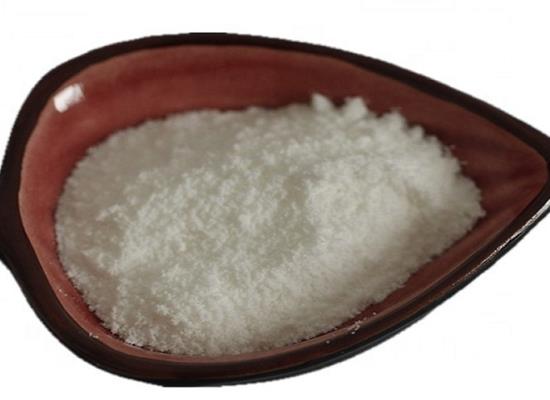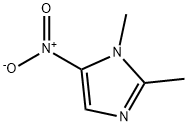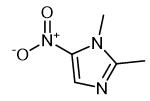1,2-Dimethyl-5-nitroimidazole: Applications in Veterinary Medicine and its Electrochemical Detection
General Description
1,2-Dimethyl-5-nitroimidazole plays a crucial role in veterinary medicine for treating protozoan and anaerobic bacterial infections in pigs. 1,2-Dimethyl-5-nitroimidazole helps combat diseases like trichomoniasis and postpartum infections, improving animal health and reproductive performance. In the electrochemical detection field, a novel sensor using cobalt molybdate hollow spheres and graphitic carbon nitride nanosheets enhances detection sensitivity and broadens the linear detection range for 1,2-Dimethyl-5-nitroimidazole residues. This sensor shows excellent stability, reproducibility, and resistance to interference, making it suitable for monitoring food safety and ensuring accurate detection of veterinary drug residues.

Figure 1. 1,2-Dimethyl-5-nitroimidazole
Applications in Veterinary Medicine
1,2-Dimethyl-5-nitroimidazole, known commercially as dimetridazole, is a nitroimidazole derivative employed as an antiprotozoal agent in veterinary medicine. This compound has proven especially effective in treating and preventing diseases caused by protozoans and certain anaerobic bacterial infections in swine. The applications of 1,2-Dimethyl-5-nitroimidazole in veterinary medicine are diverse and critical for maintaining the health and productivity of pigs. Firstly, 1,2-Dimethyl-5-nitroimidazole is highly effective in combating protozoan infections in pigs. It inhibits the oxidative reduction reactions essential for the survival of protozoans, thereby controlling diseases such as trichomoniasis, balantidiasis, and ciliates infections in pigs. These infections can severely affect the health and growth rates of swine, leading to significant economic losses, hence the importance of dimetridazole in preventing these diseases cannot be understated. Secondly, 1,2-Dimethyl-5-nitroimidazole serves a crucial role in preventing postpartum infections caused by anaerobic bacteria in sows. These bacteria, including species like Clostridium, Staphylococcus, and Fusobacterium, can cause conditions such as endometritis, mastitis, and vaginitis, all of which are detrimental to the health of the sow and can impact her reproductive performance. By inhibiting these pathogens, dimetridazole enhances the overall health of the breeding stock and improves the survival rates of newborn piglets. Lastly, 1,2-Dimethyl-5-nitroimidazole is effective in preventing and treating gastrointestinal diseases in pigs caused by anaerobic bacteria and spirochetes, such as Clostridium and Brachyspira. Diseases like swine dysentery and clostridial enteritis are serious conditions that can lead to severe diarrhea, weight loss, and even death. The use of 1,2-Dimethyl-5-nitroimidazole in controlling these infections is vital for maintaining the health of swine populations and ensuring the profitability of pork production. In summary, 1,2-Dimethyl-5-nitroimidazole is a broad-spectrum antimicrobial that plays a significant role in the management of protozoan and bacterial infections in pigs. Its use in veterinary medicine is crucial for improving animal welfare, enhancing productivity, and reducing economic losses in the swine industry. 1
Electrochemical Detection
In the research article by Yung-Fu Hsu, a cobalt molybdate (CoMoO4) hollow spheres-incorporated graphitic carbon nitride (g-CN) composite is prepared for the electrochemical detection of 1,2-Dimethyl-5-nitroimidazole (dimetridazole, DZ). The synergistic effect between the hollow-structured CoMoO4 and g-CN nanosheets facilitates the transportation of electrons through kinetic barriers, thereby providing a high electrical conductivity with increased electroactive sites. The proposed CoMoO4@g-CN-modified electrode displayed a wide linear range (0.001–492.77 μM) and a lower detection limit (LOD: 0.4 nM) for the determination of DZ through the amperometry (i–t) method. In addition, the CoMoO4@g-CN-modified electrode achieved good operational stability, anti-interfering ability (five-fold excess amount of co-interfering compounds) and reproducibility. These results demonstrate the increased electrocatalytic activity of CoMoO4@g-CN modified glassy carbon electrode (GCE) towards the detection of DZ in food samples with satisfactory recovery ranges.2
References:
[1] R L MILLER J E F. Dimetridazole therapy for swine dysentery.[J]. Modern veterinary practice, 1973, 54 6.[2] BALASUBRAMANIAN SRIRAM . Cobalt molybdate hollow spheres decorated graphitic carbon nitride sheets for electrochemical sensing of dimetridazole[J]. Food Chemistry, 2023, 430. DOI:10.1016/j.foodchem.2023.136853.
Related articles And Qustion
Lastest Price from 1,2-Dimethyl-5-nitroimidazole manufacturers

US $0.00/kg2025-05-20
- CAS:
- 551-92-8
- Min. Order:
- 25kg
- Purity:
- 98%min; BPV2013
- Supply Ability:
- 80tons/month

US $10.00/KG2025-04-21
- CAS:
- 551-92-8
- Min. Order:
- 100KG
- Purity:
- 99%
- Supply Ability:
- 100 mt



